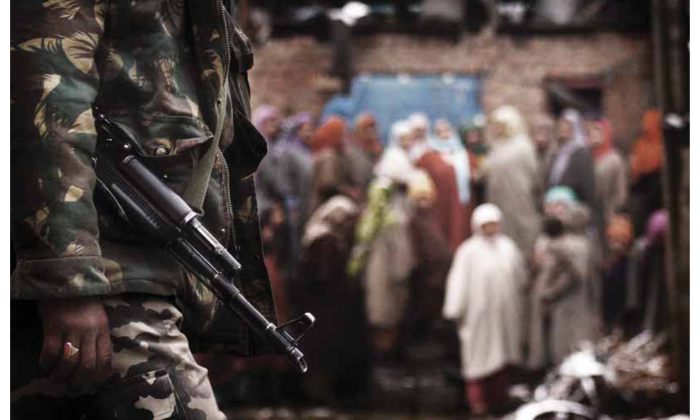The potency of the AFSPA (Armed Forces Special Powers Act) imposed in the north-east for over five decades and in Jammu and Kashmir for almost 20 years, can be gauged from the fact that even meager whimpers can evoke tumultuous reactions. To the centre, the act is almost considered sacred; its criticism or calls for revoking and diluting almost a blasphemy. The saffron brigade is quick to stonewall any opposition by invoking its patent slogan of ‘anti-national’ and the army on plea that its personnel who are fighting a tough battle against insurgency need protection.
“How do rapes and molestations fit into any of the categories provided in the AFSPA. Can rapes, like kidnappings, be deemed necessary for maintaining law and order, for self defence, for better counter insurgency operations?”
Two recent incidents are illustrative.
First is the rally in support of Irom Sharmila, a lone woman who waged a war against AFSPA, 11 years ago by going on an indefinite hunger strike and has been imprisoned and force fed ever since. On Sunday, October 16, social activists Medha Patkar and Sandeep Panday flagged off 4500 kilometers long ‘Jan Karawan’ rally in Srinagar in solidarity to Irom Chanu Sharmila’s campaign for repealing the draconian ‘Armed Forces’ Special Powers Act’ (AFSPA). The rally will complete its journey via several north Indian cities to Imphal in 27 days. Within days, the activists participating in the rally had to face a stiff resistance in Delhi from the police backed ABVP hooligans, who disrupted the rally and the police arrested the sympathisers of Irom Sharmila, forcing them to launch a campaign the next day in support of their freedom of expression and liberty to protest.
Second is the over hyped reaction to chief minister Omar Abdullah’s announcement of withdrawal of Armed Forces Special Powers Act and the Disturbed Areas Act, from certain pockets in Jammu and Kashmir. The defence ministry has immediately thrown a spanner at Omar’s proposed plans by saying an emphatic no to withdrawal of the AFSPA and Commander Hasnain has punctured the balloon of the chief minister’s claims by denying that any such issue has been under discussion in the Unified Headquarter meeting chaired by the chief minister.
What is it that makes AFSPA such a prized object? There seems little apparent logic in defending an act that can be easily opposed on grounds of both morality and legality. But the fact remains that nobody at the helm of affairs wishes or dares to even touch it. ‘Justice Jeevan Reddy Commission’ report on AFSPA, 2006, recommends repeal of the act and in its place arming the existing ‘Unlawful and Disruptive Activities Act’ with some of AFSPA’s draconian provisions. A year later, as a follow up of the prime minister’s Round Table Conference on Kashmir, the Working Group on Human Rights, headed by the present vice president Hamid Anasri, too recommended repeal of the AFSPA, deeming it to infringe on the fundamental rights of the people. Even the recent report submitted by Kashmir interlocutors before the union home minister recommends review of AFSPA.
While it is difficult to understand the official stubbornness without a justifiable argument, it is not difficult to list the reasons for opposition to AFSPA. Firstly, an act like AFSPA, modeled on the Armed Forces (Special Powers) Ordinance promulgated by the colonial British government on 15th August 1942 to suppress “Quit India Movement” makes a mockery of the claims of liberal democratic character of the Indian State as it tends to run counter to the rights provided to individuals under the. AFSPA has encouraged a vicious cycle of violence through institutionalised impunity to the armed forces to do as they please in the name of counter insurgency operations. It has thus encouraged large scale violations of human rights.
What the AFSPA does is while it gives sweeping powers to armed forces personnel, it forbids their prosecution without previous sanction by the central government. It is thus plainly, as Asit Das writes, “an instrument of war empowering the military and forces operating under it to eliminate, neutralise and destroy the enemy or suspected enemies, which more often than not practically include every body residing, in the disturbed area.” And, here is no dearth of instances and evidence to support this fact.
The law stipulates that:
Any commissioned officer or any other person of equivalent rank in the Armed Forces may, in a disturbed area, fire upon anyone even causing death, if he deems it necessary for maintenance of law and order, but only after a warning. But is there ever a sufficient warning? Who decides? There are cases of people having been shot at point blank range with enough evidence of no warning shots. How do these also get justified?
He can arrest any person on suspicion. But Section 5 of the bare act also states, that such person has to be produced at a Police Station shortly with explanation. There is a long list of cases of youth who have disappeared in custody. Many of them were picked up and detained by army personnel, with no account in any police station, and then they disappeared in custody.
If they were killed, were they killed in custody for reasons of self defence or maintenance of law and order? What about the still continuing practice of fake encounters, where boys, mostly innocent, are virtually kidnapped and killed in stage managed encounters so that some armed personnel can get promotions and other benefits? How do these fit into the bracket of maintaining law and order? Why should prior sanction be needed in prosecuting men in uniform who are involved in such crimes?
Take the case of Pathribal fake encounter, March 24, 2000, four days after the Chittisinghpora massacre, in which five innocent Kashmir civilians were picked up, shot dead and passed off as foreign militants. Both an inquiry commission headed by Justice Pandian and CBI investigation have indicted the army men. The CBI, which may have bailed out the police in the joint operation, took four long years to come to the conclusion that the five men had indeed been murdered. It filed a charge-sheet in the court of the Chief Judicial Magistrate, Srinagar, against Brigadier Ajay Saxena and 4 others of 7th Rashtriya Rifles, accusing them of murder under Section 302 of the Ranbir Penal Code. That was in July 2006. More than five years hence, the trial is yet to begin because the army refuses to budge without a union government’s sanction that is still wanting. The killings, however, do not justifiably fall in any of the categories listed in AFSPA Act.
How do rapes and molestations fit into any of the categories provided in the AFSPA. Can rapes, like kidnappings, be deemed necessary for maintaining law and order, for self defence, for better counter insurgency operations? Security personnel have got away from prosecution in cases of rapes on the argument that they cannot be prosecuted without proper sanction of the Centre. In cases, where a departmental enquiry has been pursued against them, they have got away with simple suspensions or remarks like ‘guilty of misconduct’ like in the case of the mother-daughter rape case of Badar-Payein, Handwara, November 2004. The Indian laws, however, can sentence rape convicts for upto seven years rigorous imprisonment.
Such blanket impunity has encouraged a high graph of human rights abuse and rampant killings without a system of accountability in Kashmir, like the north-eastern states of the country. The defence of AFSPA is weak not only on grounds that it seeks to impinge on the civil liberties and the right to life of the people in the disturbed area. It stands on a sticky wicket even legally, despite a supreme court ruling in the case of Human Rights Forum Vs Union of India and State of Manipur filed on October 10, 1980. (The apex court states that after adjudicating the AFSPA for over 18 years, the apex court had finally upheld the Constitutional validity of all the clauses of the Act.) In the north-east, it was promulgated for a year but continues to remain intact even more than six decades on. In Kashmir case, the AFSPA can be challenged legally on grounds that it was never ratified, nor extended by the Jammu and Kashmir assembly, since all central laws are to be duly extended through ratification by the state’s assembly as per the special status of the state. In Jammu and Kashmir, however, the Act was brought in during the Governor’s rule, by notification in the official Gazette, in 1992 for a period of six months and remains unchallenged ever since. Bypassing duly elected and representative political authority is tantamount to de facto imposition of emergency.
In reply to an application under Right to Information Act by the Jammu and Kashmir Coalition of Civil Societies (JKCCS), the State Home Department of the Jammu and Kashmir on September 6, 2011 claims that from 1989 to 2011, they have applied for sanction for prosecution from Ministry of Defence and Ministry of Home Affairs under section 7 of AFSPA in 50 cases only. Within these 50 cases stated to be applied by the State Home Department for sanction under AFSPA, sanction for prosecution is awaited in 16 cases and is declined in 26 cases.
Need we say more about a law that is undemocratic, inhuman, allows indiscipline and puts a virtual closure on any system of accountability. The case rests.


